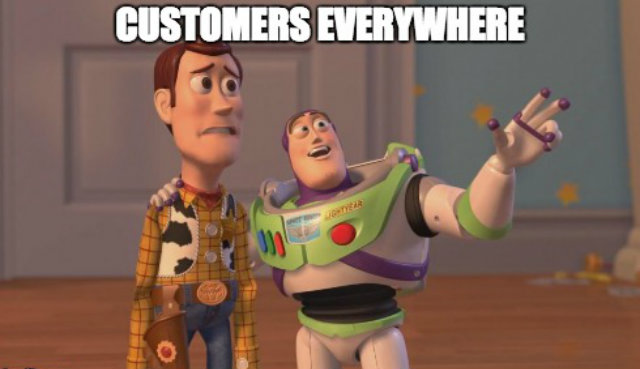
If you are running a retail company - whether bricks and mortar or online - you are probably already dealing with the digital transformation, a transition that involves business models, technology and - ultimately - the way you think and act. Your client is the most important person in your business: this is the undeniable fact that drives this change and forces you to rethink your retail marketing strategy.
A truly customer-oriented retailer is the one that has all the resources - not just the budget - to build a solid connection with customers, empowered by new technologies and mobile devices. How many companies are ready to embrace this challenge? A recent study from SDL and Econsultancy noticed that:
“retailers are overwhelmed by the complexity of data, technology and understanding of the customer journey, (...) acutely aware of their technological shortfalls when it comes to creating a seamless, personalized customer experience across multiple channels.”
We are way beyond the stage where retailers still debate the importance of customer experience management. The evolution of markets, competitors and - above all - customers has forced brands to revolutionize their strategies, rebuild the overall idea of store and rewrite the customer experience map.
What does this mean for your strategy? In a few words, that any action you plan and execute must start and end with the customer. This path is swiftly becoming mandatory but, between saying and doing, there lies an ocean full of doubts and questions. We come to the aid of all retailers, tracing the 5 steps to adapt retail marketing strategy and the approach to digital customer experience.
-
Start with the customer - given the premise, the first step to renew your strategy can only be the focus on customers. We have entered the Age of the Customer, where clients are not just the primary source of your revenues; they are the ultimate source of your meaning. Identify your buyer persona and be sure that everything you do revolves around them. Product and service customization is a rising trend in markets made flat by the homogenization.
-
Retail is detail - this is one of the most famous principles in retailing. 'Oldie but a goldie', it tells an indelible truth: success lies in how much detailed is your knowledge of customers. The emergence of big data platforms and proximity marketing tools (iBeacon, Geo-Fencing, Internet of Things) help you personalize the shopping experience and improve the buyer's journey across all touch points and devices.
-
The journey above the 4 P’s - for decades, retailers have built their strategies on the certainty that the 4 P's were the foundations of business: Product, Price, Place and Promotion. In the era of mobile-mind shift, we now know that there is one key factor that traditional funnels guiltily ignore: the experience. The journey has become the main brand differentiator, because today people demand compelling experience, not just functional products.
-
From brick to byte: the Internet is already the primary source of product information. The purchase decision is influenced by your online presence ... if you have one. Today, 'store' doesn't mean just brick-and-mortar, and retailers need to grow both in the digital and the physical world. Omni-channel commerce, mobile service and social media connections are just few examples of the importance of the passage from brick to bytes.
-
Big data drive big sales: new technologies mean new opportunities to gather information about competitors and customers. Smartphones, wearables, push notifications, and geolocation generate an indistinct stack of data, that could help you guide the customer along the purchase path. To make better strategic decisions and increase sales, you must convert numbers into reliable insights: big data mining and web analytics work better together and thus become necessary tools.
Retailers are well-aware that they must work to improve service to stay in business. The debate between customer acquisition and customer retention in blurring: social media, smartphones, wearables, proximity marketing are pushing the boundaries of retail forward. At the end, the difference between retail and e-retail is destined to disappear, and the key to success will be the ability to rebuild customer experience for the digital era.
If you want to know more about the wind of change driving retail to the new era, check the following articles:
5 Online Retail Marketing Tips To Improve Customer Experience
Why Mobile Will Help Improve Retail Customer Experience
Top 5 Technologies That Will Change Retail Customer Experience



 Your magnifing glass to deeply understand your users and increase the value of each relatonship.
Your magnifing glass to deeply understand your users and increase the value of each relatonship. Listen to the voice of your customers deeply to understand what they truly want.
Listen to the voice of your customers deeply to understand what they truly want. The Lead Generation Platform to get leads from anonymous traffic on your website.
The Lead Generation Platform to get leads from anonymous traffic on your website.  Understand the behavior of people in physical spaces and monitor safety requirements.
Understand the behavior of people in physical spaces and monitor safety requirements. The Digital Commerce Platform designed to follow the most modern technological standards..
The Digital Commerce Platform designed to follow the most modern technological standards.. The XReality platform to tell brand and product stories by connecting physical and digital worlds.
The XReality platform to tell brand and product stories by connecting physical and digital worlds. Points, rewards, levels, badges, missions: a world of nudges to nurture your customer community.
Points, rewards, levels, badges, missions: a world of nudges to nurture your customer community. Discover all the other solutions!
Discover all the other solutions!









